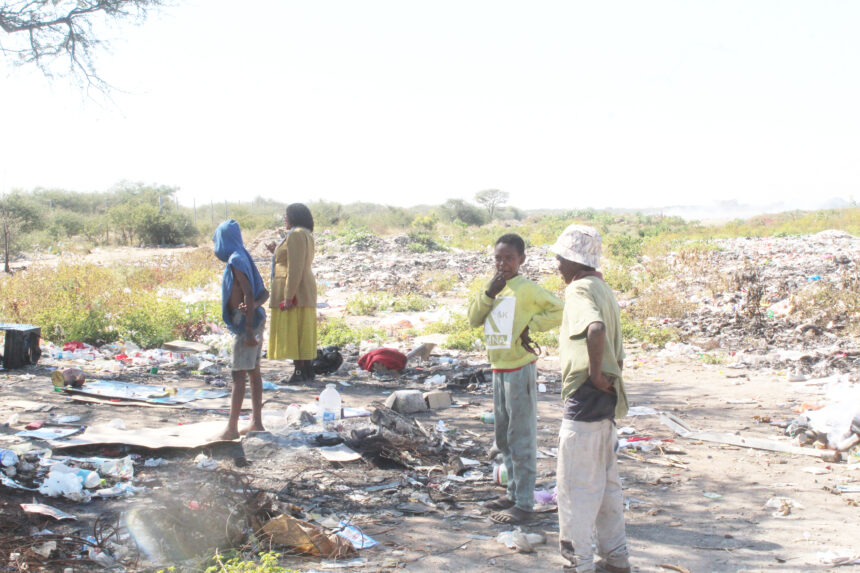GROOTFONTEIN – While many Namibians are seeking warmth indoors, a hidden community lives permanently in makeshift plastic shelters at the Grootfontein dumpsite, surviving on expired and rotten food.
The group consists of over 30 people, including children under 18. New Era visited the dumpsite on Wednesday last week, accompanied by Grootfontein mayor Talitha Garises and spokesperson Luke Salom, to witness the conditions.
The site, located on the outskirts of the town, was teeming with people scavenging through heaps of garbage, trying to find something to eat or a piece of scrap to sell.
Among them was Makanga Heibeb, an 18-year-old who has been living at the dumpsite permanently for the past five years. He began scavenging at the age of five. “I decided to move here because I do not want to steal. We did not have food at home. My parents forced me to hustle to make a living. Life was tough for me to balance both school and street hustling. Therefore, I later dropped out of school,” he narrated.
While on site, the mayor confirmed that the crisis had reached her doorstep.
“I am asking that the drought relief food be extended to the office of the mayor because, every day, street kids flock to my office, looking for something to eat,” she said.
“In most cases, I do not have food to give them, and I feel helpless. It’s heartbreaking to turn them away,” she shared. The mayor said this problem is not new. In 2022, she initiated a ‘Work for Food’ programme, employing locals from impoverished areas to clear bush around the hospital, an area previously plagued by muggings and attacks.
She coordinated food support for the workers through donations, and even secured cash support from a local businessman to reward the workers with N$450 each.
But that initiative was short-lived. The hunger crisis, particularly among young people, has only worsened.
Dumpsite
Back at the dumpsite, Alex Somseb (22) shared his story. “I moved here three years ago, but I’ve been coming here since I was a child with my parents. We would collect food and return home, but it was never enough. That’s why I decided to build a home here and stay permanently,” he said.
Abraham Hauseb (30), who has lived at the dumpsite for four years with his brother, said he has scavenged there for over a decade.
“I later started struggling to make a living. I couldn’t afford basic things like water. But here, I don’t need to pay for water or food – even though the food is not fit for human consumption,” he shared emphatically.
Another dumpsite dweller, Thomas Hoxobeb, used to regularly visit the mayor’s office in search of food. “But there was nothing to give me. That’s why I decided to move to the dumping site to survive,” he said. The situation has left Garises deeply concerned about the health and safety of those living in such conditions, especially during winter. She appealed to both government and private stakeholders to consider direct food relief to local government offices, where immediate community interventions can take place.
“These people are not criminals. They are just hungry,” she said. The mayor has expressed concern over the growing number of street children turning to her office for food, saying the municipality is overwhelmed and needs urgent support from other institutions and the community.
Work for food
Speaking during an interview at her office, the mayor recalled how her initiative to feed unemployed volunteers in 2022 led to a spike in demand for food support, especially from vulnerable young people. “Every day, I have to feed those people food,” she said, describing the Work for Food project she initiated at the time. “We had to cook there at the hospital to feed them and also give them uncooked food, maize meal and so on for their family members.
The project, which began as a temporary clean-up campaign around the local hospital, was aimed at addressing rampant crime caused by criminals hiding in overgrown bushes.
But what began as a solution to improve safety quickly became a humanitarian challenge.
“At first, they just needed food. But later on, they said, ‘We also need money. We cannot just eat here and go back home. People at home are hungry,’” the mayor recounted.
She said her office is now frequently approached by street children, many of whom are not only hungry but also desperate for employment.
“They flock to my office daily, asking for food. It’s heartbreaking. They say, ‘Mayor, we heard that you are the one who helps.’ But this is not sustainable,” she said. The mayor clarified that the initial Work for Food campaign was never intended to become a social welfare programme.
“It was my initiative. It was not my job. It was supposed to be the work of the regional office,” she highlighted. Garises sought help from local businesses to feed and eventually pay the volunteers. “One businessperson gave me N$15 000 cash. I divided it among the people, and each one received N$450. They were very grateful,” she said. The rising demand for food and support, particularly from street children, has now prompted the municipality to consider more structured interventions.


